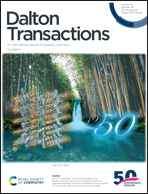Encapsulating third donors into D–A hybrid heterostructures to form three-component charge-transfer complexes for enhanced electrical properties†
Abstract
D–A hybrid heterostructures are an emerging class of crystalline hybrid materials composed of semiconductive inorganic donors and organic acceptors. However, due to the steric effects of the inorganic coordination sites, it is difficult for the large organic molecules to form compact packing at the molecular level, resulting in the poor efficiency of photoinduced charge transfers. To achieve an effective carrier separation and transfer, herein we incorporated third donors into a copper(I) halide/thiazolo[5,4-d] thiazole D–A heterostructure to construct three novel three-component complexes (Me2-Py2TTz)Cu4I6·(I2) (1), (Me2-Py2TTz)Cu3I5·(pyrene) (2) and (Me2-Py2TTz)Cu3I5·(perylene) (3) (Py2TTz = 2,5-bis(4-pyridyl) thiazolo[5,4-d] thiazole), respectively. Due to the spatial distances as well as the orbital energies between the copper(I) halide and thiazolo[5,4-d] thiazole units bridged by third donors, they are excellent three-component charge-transfer complexes (CTCs) with enhanced electrical properties.



 Please wait while we load your content...
Please wait while we load your content...